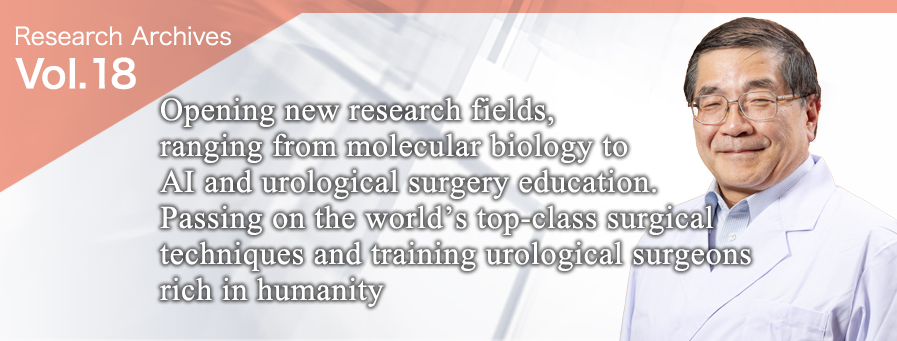
Department of Renal and Genitourinary Surgery, Graduate School of Medicine, Hokkaido University
Nobuo Shinohara, M.D., Ph.D.surgery
March 2024: Retirement from his position at Hokkaido University
- 1984: M.D., Hokkaido University School of Medicine
- 1984-85: Residency, Hokkaido University Hospital, Urology
- 1985-87: Tomakomai City Hospital, Urology
- 1987-89: Wakkanai City Hospital, Urology
- 1989-90: Visiting fellow, University of Michigan, Urology
- 1992-99: Assistant Professor, Department of Urology, Hokkaido University Hospital
- (1996: Ph.D., Hokkaido University School of Medicine)
- 1999-2005: Lecturer, Department of Urology, Hokkaido University Hospital
- 2005-14: Associate Professor, Department of Renal and Genitourinary Surgery, Hokkaido University Graduate School of Medicine
- 2014-: Professor, Department of Renal and Genitourinary Surgery, Hokkaido University Graduate School of Medicine
Science, art and humanity are essential for clinical doctors
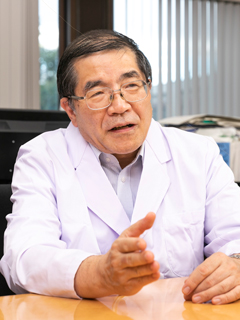
Sir William Osler (1849-1919) advocated that “clinical training = bedside learning” to provide medical students practical on-the-job training face-to-face with patients, and built the foundation of modern medical education. He said, “The practice of medicine is an art, based on science.*”
Professor Nobuo Shinohara, who has been the leader of the Department of Renal and Genitourinary Surgery and the Urology Department of the Hokkaido University Hospital since October 2014, sets the teaching of this great pioneer as his goal, and believes that “Science, art and humanity are the three essential elements for clinical doctors.” Based on his own experience of being fascinated by basic research when he worked on the elucidation of the mechanism of genes that cause drug resistance in bladder cancer at the University of Michigan, he states his belief that “Urologists who understand science can engage in clinical practice with a broad view. Having a certain period of time to immerse themselves in study contributes greatly to their growth as doctors.”
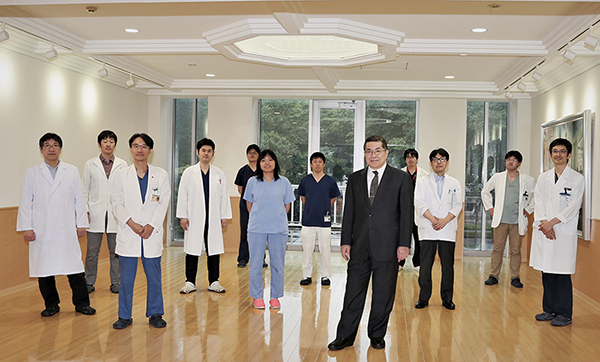 Under the guidance of Professor Shinohara, young doctors in the Department develop humanity and a sense of ethics required for their profession. Female doctors and researchers are also accepted actively. The professor says, “The Department cannot exist if women avoid the field of urology. Today, surgery is robotized and requires manual dexterity rather than strength. There are many opportunities for female doctors to use their skills.”
Under the guidance of Professor Shinohara, young doctors in the Department develop humanity and a sense of ethics required for their profession. Female doctors and researchers are also accepted actively. The professor says, “The Department cannot exist if women avoid the field of urology. Today, surgery is robotized and requires manual dexterity rather than strength. There are many opportunities for female doctors to use their skills.”
Medical care and research are conducted mainly by dividing the staff into four groups specializing in urologic oncology, voiding disturbance·urogynecology, renal transplantation and pediatric urology.
Experienced staff members serve as group leaders and conduct training regularly for the acquisition of the latest surgical techniques, such as laparoscopy and the robot-aided surgical system (da Vinci). “We have established an environment in which doctors who gained experience here can go to affiliated hospitals throughout Hokkaido and provide the highest-level medical care in local cities in 5 to 10 years. Today, young doctors have more opportunities to engage in surgery, including da Vinci, in local cities. The system we have in place that enables them to acquire sufficient technical skills under the guidance of their seniors is functioning.”
*Hinohara, S. & Niki, H., (2001). Osler's “a way of life” and other addresses, with commentary and annotations. Durham & London: Duke University Press.
Opening new basic and clinical research fields is the specialty of the Department
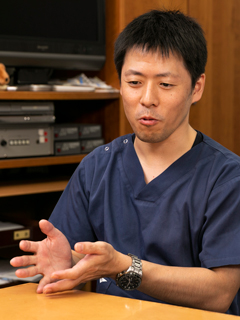
The Department of Renal and Genitourinary Surgery recommends enrollment in the graduate school to students around six years after graduating from the Faculty of Medicine. Applicants other than doctors are also accepted and receive guidance provided mainly by group leaders. Graduate students have the freedom of conducting research projects in clinical and basic fields and are active in presenting their research results at academic meetings and in medical journals at home and abroad.
In basic research, emphasis is placed on research on the tumor endothelial cells of urological cancer. In 2017, a graduate student discovered the increased development of a drug transporter known as ABC1, which releases an anticancer drug in the tumor endothelial cells of urothelial cancer. The project won the best poster award at the Annual Meeting of the Japanese Association for Metastasis Research. If what hinders the effect of anticancer drugs can be determined in this research project, it is expected to achieve further results, such as the development of new treatment methods.
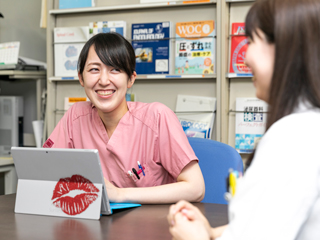
In clinical research, the opening of new research fields is the specialty of the Department. One example is research on renal and genitourinary surgery conducted by the staff. Research papers are written jointly with researchers overseas on the subject of “How should young doctors learn laparoscopy and other techniques?” and submitted to medical journals. The existence of such staff members is the proof of the Department’s excellent educational support system. Professor Shinohara also praises the staff as “highly valuable in the sense that they have opened new research fields.”
Professor Shinohara also has high expectations on the automated diagnosis of prostate cancer location by artificial intelligence in multiparametric MRI as being at the forefront of the field in the world because of the uniqueness of the idea. A graduate student developed an image analysis algorithm himself and established an epoch-making diagnosis program. The project won the Annual Meeting Award in the poster category at the 2018 Annual Meeting of the Japanese Urological Association.
The voiding disturbance and urogynecology group engages in the clarification of the pathology of incontinence and the search for new drugs. In addition, graduate students in the doctoral and master’s courses who are also physical therapists and clinical laboratory technicians conduct research on pelvic floor muscle exercises for the prevention of incontinence. They are balancing their work and research in an effort to provide a scientific background for the methods and effects of exercises to strengthen the muscles supporting the pelvis.
Although all research projects are excellent, Professor Shinohara says, “Research projects are not always successful, but I want students to have the experience of thinking of the reason even if they did not get expected results.” I want them to know the ideas of and communicate with people other than doctors through their research. I want them to be on the side of patients at all times and, when patients’ conditions worsen, make the most of their experience in the problem-oriented system (POS) in which they treat the patients and solve their problems based on the understanding of the cause of such conditions.” He emphasizes that research papers are not the only fruit of research.
(Interviewed in September 2018)
Urethroplasty in children highly praised by an American urologist
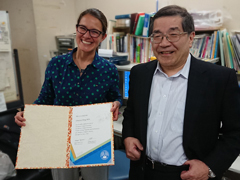
Reparative surgery for hypospadias in children is said to be among the most difficult surgical procedures in urology. Replication studies on one-stage urethroplasty with parameatal flap (OUPF) VI, which is a surgical procedure developed by the Department’s second professor Tomohiko Koyanagi (currently Professor Emeritus of Hokkaido University) in 1994, are still conducted throughout the world. American pediatric urologist Dr. Christina Ching visited the Department in April 2018 to learn the technique through the observation of surgery and other activities during her two-week stay. After returning to the United States, Dr. Ching wrote in the AUA News, which is the official magazine of the American Urological Association, “The technical level of the Urology Department of the Hokkaido University Hospital is very high. Everyone should visit there.”


